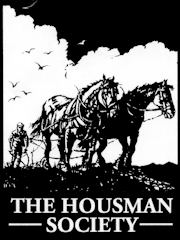A Shropshire Lad
|
Key: V: Textual Variation. C: Commentary. Q: Question. Glossary
Top ▲ Glossary
| Line | Word | Glossary |
| 16 | handselled | Tested, tried, proved |
| 18 | lief | Readily or without reluctance |
Top ▲ Variations
| Line | Text | Textual variation |
| 3 | D1 | <In hamlets of old long livers>, \ The country <of> \ for / quiet livers |
| 3 | D2 | easy] <quiet> |
| 5 | D1 | <The heart had> \ <There still were> / \ We still had / troubles to lighten |
| 5 | D2 | <We still had sorrows \ <trouble> <burdens> / to lighten → Still we had loads to lighten |
| 6 | D2 | be always] \ <for ever> / |
| 7 | D1 | <And> <lads> Lads <could be> \ <were> / \ <would be> / <sorry> \ <had sorrows> knew sorrow / at Knighton <,> |
| 7 | D2 | <Lads> \ And lads / knew trouble \ <sorrows> / at Knighton |
| 12 | D1 | sorrow] trouble with one} <on me> |
| 17 | D2 | <Where shall the porter \ <can one halt> <and>/ \ to / deliver → Where <can> \ does / one halt to deliver |
| 18 | D2 | <The luggage that wearies \ <loads> / him |<one> me / down?> → <The> This luggage I’d life set down? |
| 21 | D2 | <Further> [←’Tis] further than Teme or \ <and> / Knighton,> \ ’Tis a long way further than Knighton, / → <A long way \ <’Tis long leagues> further than Knighton |
Top ▲ Questions
| Line | Question |
| 5 | Consider the progression of expression in the drafts for the first part of the line: “The heart had” becomes “There still were” and then “We still had“. How does the idea of the line change with each amendment? |
| 5 | Compare the different words used in the drafts: “troubles“, “burdens” and “loads“, before “sorrows” is used in the final version. Why do you think was the final choice made? |
| 10 | Why is London described as “the town built ill“? |
| 21 | Where is this place, “a long way further than Knighton, | A quieter place than Clun“? |
| 24 | What mood is established by the end of the poem? |

Top ▲ Commentary